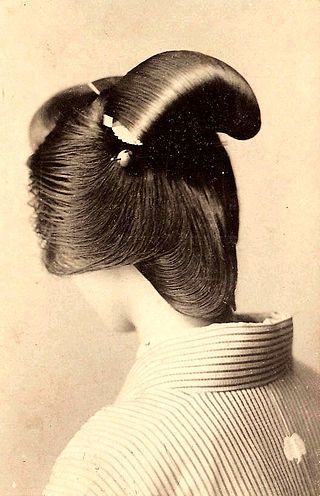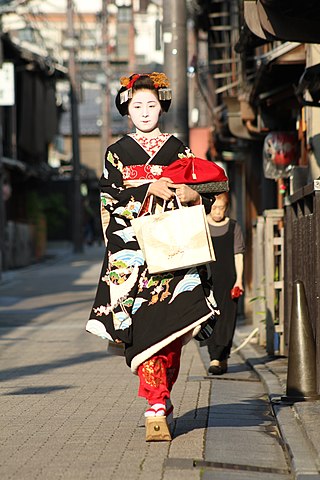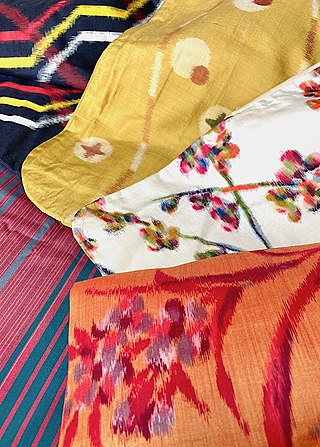
The kimono is a traditional Japanese garment and the national dress of Japan. The kimono is a wrapped-front garment with square sleeves and a rectangular body, and is worn left side wrapped over right, unless the wearer is deceased. The kimono is traditionally worn with a broad sash, called an obi, and is commonly worn with accessories such as zōri sandals and tabi socks.

There are typically two types of clothing worn in Japan: traditional clothing known as Japanese clothing, including the national dress of Japan, the kimono, and Western clothing, which encompasses all else not recognised as either national dress or the dress of another country.

Hakama are a type of traditional Japanese clothing. Originally stemming from kù, the trousers worn by members of the Chinese imperial court in the Sui and Tang dynasties, this style was adopted by the Japanese in the form of hakama in the 6th century. Hakama are tied at the waist and fall approximately to the ankles. They are worn over a kimono specially adapted for wearing hakama, known as a hakamashita.

Tabi are traditional Japanese socks worn with thonged footwear such as zori, dating back to the 15th century.

Geta are traditional Japanese footwear resembling flip-flops. A kind of sandal, geta have a flat wooden base elevated with up to three "teeth", held on the foot with a fabric thong, which keeps the foot raised above the ground.

An obi is a belt of varying size and shape worn with both traditional Japanese clothing and uniforms for Japanese martial arts styles. Originating as a simple thin belt in Heian period Japan, the obi developed over time into a belt with a number of different varieties, with a number of different sizes and proportions, lengths, and methods of tying. The obi, which once did not differ significantly in appearance between men and women, also developed into a greater variety of styles for women than for men.

Nihongami is the term used for a number of traditional Japanese hairstyles considered to be distinctive in their construction and societal role.

Geisha (芸者), also known as geiko (芸子) or geigi (芸妓), are female Japanese performing artists and entertainers trained in traditional Japanese performing arts styles, such as dance, music and singing, as well as being proficient conversationalists and hosts. Their distinct appearance is characterised by long, trailing kimono, traditional hairstyles and oshiroi make-up. Geisha entertain at parties known as ozashiki, often for the entertainment of wealthy clientele, as well as performing on stage and at festivals.

Scholars agree that Japanese armour first appeared in the 4th century, with the discovery of the cuirass and basic helmets in graves. During the Heian period (794–1185), the unique Japanese samurai armour ō-yoroi and dō-maru appeared. The Japanese cuirass evolved into the more familiar style of body armour worn by the samurai known as the dou or dō, with the use of leather straps (nerigawa), and lacquer for weatherproofing. Leather and/or iron scales were also used to construct samurai armours, with leather and eventually silk lace used to connect the individual scales (kozane) of these cuirasses.

The kosode was a type of short-sleeved Japanese garment, and the direct predecessor of the kimono. Though its component parts directly parallel those of the kimono, its proportions differed, typically having a wider body, a longer collar and narrower sleeves. The sleeves of the kosode were typically sewn to the body entirely, and often featured heavily rounded outer edges.

A hanten (袢纏) is a short winter coat and an item of traditional Japanese clothing. The hanten started to be worn, especially by the common people, in the 18th century, during Japan's Edo period (1603-1867).

Fukagawa (深川) is a district in Kōtō, Tokyo. It is traditionally part of the Shitamachi area of Tokyo. Formerly, it was a ward of the historical Tokyo City. In 1947, Fukagawa was incorporated into the ward of Kōtō, together with Suginami.

A maiko is an apprentice geisha in Kyoto. Their jobs consist of performing songs, dances, and playing the shamisen or other traditional Japanese instruments for visitors during banquets and parties, known as ozashiki.

Kimono that carried designs depicting scenes from contemporary life became popular in the Empire of Japan between 1900 and 1945, during Japan's involvement in WWII. Now referred to as omoshirogara, the decoration of many kimono produced during this time often depicted the military and political actions of Japan during its involvement in the war on the side of the Axis powers. In English, these kimono are commonly referred to as 'propaganda kimono'. Traditional items of clothing that were not kimono, such as nagajuban (underkimono), haori and haura also featured wartime omoshirogara, as did miyamari, the kimono worn by infants when taken to a Shinto shrine to be blessed. Omoshirogara garments were typically worn inside the home or at private parties, during which the host would show them off to small groups of family or friends, and were worn by men, women and children.

The Khalili Collection of Kimono is a private collection of more than 450 Japanese kimono assembled by the British-Iranian scholar, collector and philanthropist Nasser D. Khalili. It is one of eight collections assembled, published and exhibited by Khalili, each of which is considered to be among the most important collections within their respective fields.

Japanese clothing during the Meiji period (1867–1912) saw a marked change from the preceding Edo period (1603–1867), following the final years of the Tokugawa shogunate between 1853 and 1867, the Convention of Kanagawa in 1854 – which, led by Matthew C. Perry, forcibly opened Japanese ports to American vessels, thus ending Japan's centuries-long policy of isolation – and the Meiji Restoration in 1868, which saw the feudal shogunate dismantled in favour of a Western-style modern empire.

A tanmono is a bolt of traditional Japanese narrow-loomed cloth. It is used to make traditional Japanese clothes, textile room dividers, sails, and other traditional cloth items.

Hifu is a kind of jacket traditionally worn over a kimono. Towards the end of the Edo Period (1603–1867), it was worn by men in cultural positions, such as by chajin and haijin. It later came to be worn by women. Sodenashi hifu are sleeveless and more likely to be worn by children, while sleeved hifu are more often worn by adults. Sleeveless hifu serve as smocks, protecting the clothing underneath, while sleeved hifu are more likely to be worn for warmth. Sleeveless hifu are commonly seen as part of a child's clothing when worn for Shichi-Go-San.

Meisen is a type of silk fabric traditionally produced in Japan; it is durable, hard-faced, and somewhat stiff, with a slight sheen, and slubbiness is deliberately emphasised. Meisen was first produced in the late 19th century, and became widely popular during the 1920s and 30s, when it was mass-produced and ready-to-wear kimono began to be sold in Japan. Meisen is commonly dyed using kasuri techniques, and features what were then overtly modern, non-traditional designs and colours. Meisen remained popular through to the 1950s.




















